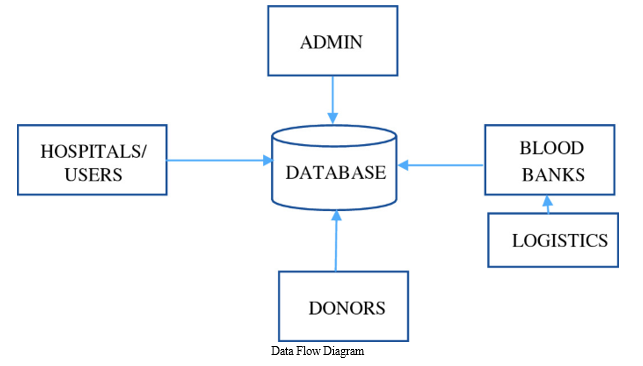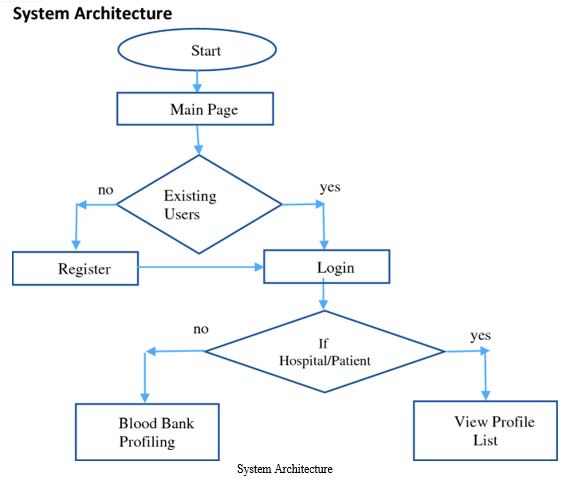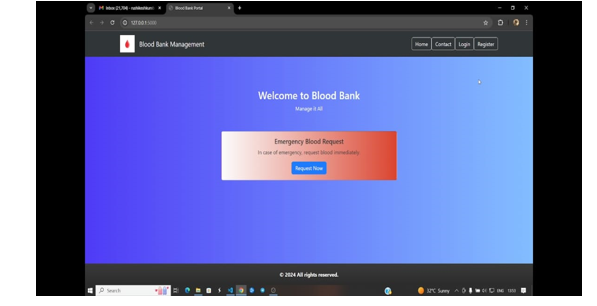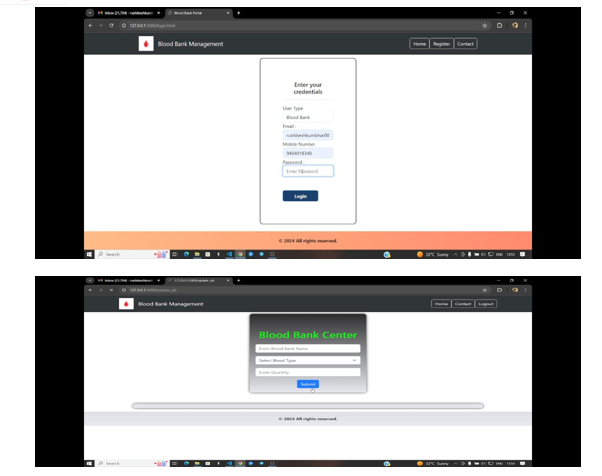Ijraset Journal For Research in Applied Science and Engineering Technology
- Home / Ijraset
- On This Page
- Abstract
- Introduction
- Conclusion
- References
- Copyright
Blood Link
Authors: Prof. U.M. Bansode, Prasanna Kulkarni, Onkar Sarvade, Yogesh Kedar, Kaushal Nikam
DOI Link: https://doi.org/10.22214/ijraset.2024.62573
Certificate: View Certificate
Abstract
In the face of medical emergencies, the rapid and reliable delivery of blood to hospitals can be a matter of life and death. This project presents \"BloodLink,\" a comprehensive solution that leverages modern web technologies and drone delivery systems to streamline the blood supply chain between blood banks and hospitals. The front-end of the system is developed using HTML, CSS, and JavaScript, ensuring a user-friendly interface for hospital staff to post blood group requirements. The backend is powered by the Flask framework of Python, facilitating robust and scalable server-side operations. Utilizing the Google Maps API, our platform dynamically identifies and displays the nearest blood banks in response to hospital requests, ensuring timely and accurate information. For critical situations requiring immediate action, we have integrated an innovative drone delivery system designed to expedite the transportation of blood to the requesting hospitals. The software development phase of the project is complete, and efforts are currently focused on the practical design and implementation of the drone system. This paper details the architecture, development process, and potential impact of \"BloodLink\" in revolutionizing emergency blood delivery and hospital blood bank coordination.
Introduction
I. INTRODUCTION
In medical emergencies, the prompt and efficient delivery of blood can be the difference between life and death. Traditional methods of blood distribution often face logistical challenges, including delays and inefficiencies in matching supply with demand. This paper introduces "BloodLink," an innovative system designed to optimize the blood supply chain by connecting hospitals and blood banks through a web-based platform. Leveraging modern web development tools such as HTML, CSS, and JavaScript for the front end and the Flask framework of Python for the backend, BloodLink provides a seamless interface for hospitals to post urgent blood group requirements. The integration of the Google Maps API enables real-time identification of the nearest blood banks, ensuring timely responses to hospital requests. This system not only enhances the coordination between hospitals and blood banks but also improves the overall efficiency of the blood supply chain.
A key feature of BloodLink is its ability to facilitate quick and accurate communication between hospitals and blood banks, reducing the time taken to locate and request specific blood types. Additionally, BloodLink envisions the future integration of a drone delivery system to expedite the transportation of blood in critical situations, bypassing traffic and other ground-based delays. This aspect of the project is currently in development, aiming to provide a rapid response mechanism that could significantly enhance emergency medical services. This research paper explores the development and implementation of BloodLink, highlighting its current capabilities and discussing the potential impact and future enhancements, including drone-based delivery, to revolutionize emergency blood distribution. The paper also examines the challenges faced during the development process and how they were addressed to create a reliable and efficient system.
II. OBJECTIVES
This project aims to develop a web-based platform, "BloodLink," to enhance communication and coordination between hospitals and blood banks for efficient blood supply management. Using modern web technologies such as HTML, CSS, JavaScript, and Flask, the platform will provide a user-friendly interface and robust backend infrastructure. Integration of the Google Maps API will enable real-time identification of nearest blood banks, optimizing response times. The primary objective is to streamline the process of blood type requests and improve overall efficiency in emergency blood distribution. Future plans include integrating drone delivery systems to expedite transportation, assessing system impact, ensuring reliability and security, and providing comprehensive user support.
III. LITERATURE SURVEY
Efficient blood supply management during emergencies remains a critical challenge in healthcare systems worldwide. Traditional methods have often been hindered by delays in matching blood supply with demand, exacerbated by inadequate communication channels between hospitals and blood banks.
Recent advancements in web-based platforms have shown promising results in improving these processes. Platforms like "BloodLink" utilize HTML, CSS, JavaScript, and Flask to create intuitive user interfaces and robust backend systems. These technologies enable hospitals to quickly post blood group requirements, which are then processed through automated algorithms to identify the nearest blood banks using the Google Maps API. Such integration not only streamlines logistics but also enhances the overall responsiveness of blood distribution networks.
Moreover, the literature underscores the transformative potential of drone technology in revolutionizing emergency blood delivery. Drones offer a novel solution to circumvent traditional transportation challenges, such as traffic congestion and infrastructure limitations, thereby reducing delivery times for critical medical supplies. Research has demonstrated the feasibility of using drones for delivering blood samples and medical supplies in various settings, highlighting their capability to operate autonomously and swiftly navigate urban environments. Integrating drones into the BloodLink platform represents a forward-thinking approach to enhancing emergency response capabilities, though challenges remain in ensuring regulatory compliance, airspace management, and operational safety.
Furthermore, studies emphasize the importance of system reliability, security, and scalability in deploying digital solutions within healthcare environments. Robust cybersecurity measures are essential to protect sensitive patient information and maintain the integrity of blood supply chain operations. Scalability considerations are crucial for expanding the platform's reach to encompass more hospitals and blood banks, thereby maximizing its impact on healthcare delivery. The evaluation of existing literature underscores the significance of user-centric design principles in developing intuitive interfaces that facilitate seamless interaction between healthcare providers and technological systems.
In conclusion, while advancements in technology offer promising solutions to enhance emergency blood supply management, ongoing research and innovation are essential to address remaining challenges and optimize system performance. By building upon the insights gained from existing literature and technological frameworks, this project aims to contribute to the evolution of emergency medical services, ensuring more efficient and responsive blood distribution networks. Future research directions include further refining drone delivery capabilities, evaluating the long-term impact on healthcare outcomes, and fostering collaboration between stakeholders to promote sustainable innovation in healthcare logistics.
IV. IMPLEMENTATION DETAILS


V. IMPLEMENTATION DETAILS OF MODULES
The implementation of "BloodLink" begins with the development of a user-friendly and responsive frontend interface using HTML, CSS, and JavaScript. HTML provides the structural framework for content presentation, while CSS ensures consistent styling and layout across different devices and browsers. JavaScript enhances user interaction with dynamic elements such as real-time updates and interactive forms, facilitating seamless communication between hospitals and the BloodLink platform.
In parallel, the backend architecture of BloodLink utilizes the Flask framework, a versatile and lightweight Python web framework. Flask enables efficient handling of server-side operations, including request processing, data management, and interaction with external APIs. The integration of the Google Maps API within Flask plays a crucial role in geolocating hospitals and blood banks, dynamically updating their availability statuses, and optimizing the routing of blood deliveries based on real-time traffic conditions.
Key functionalities of BloodLink include an algorithmic engine that processes hospital requests for specific blood types and matches them with the nearest blood banks possessing the required inventory. This algorithm ensures rapid response times and efficient allocation of blood resources, critical in emergency medical scenarios where every minute counts. Robust data encryption techniques and adherence to healthcare data privacy regulations safeguard sensitive patient information throughout the system, ensuring confidentiality and integrity.
Looking ahead, the project roadmap includes the phased development and integration of a drone delivery system to complement existing ground-based logistics. Initial steps involve feasibility studies to assess the operational viability of drones in delivering blood supplies, regulatory compliance checks to navigate airspace regulations, and prototype testing to validate safety and reliability.
The future integration of drones aims to further enhance BloodLink's capabilities by enabling rapid, direct delivery of blood units to hospitals, circumventing traffic congestion and infrastructure limitations that may delay traditional ground transportation methods.
Throughout the implementation process, continuous testing, user feedback integration, and iterative improvements are pivotal to refining BloodLink's functionality and usability. Regular updates and enhancements ensure that the platform remains adaptive to evolving healthcare needs and technological advancements, ultimately supporting healthcare providers in delivering timely and efficient emergency medical services.
VI. METHODOLOGY & RESULT
The methodology for developing "BloodLink" involves a systematic approach to ensure the robustness, functionality, and reliability of the platform. The project begins with a comprehensive analysis of requirements gathered from healthcare professionals and stakeholders, identifying critical functionalities such as real-time blood type tracking, user-friendly interface design, and seamless integration with external APIs.
Following the requirements analysis, the frontend development phase employs HTML, CSS, and JavaScript to create a visually appealing and responsive user interface. HTML structures the content, CSS styles the interface for consistency across devices, and JavaScript adds dynamic features such as live updates and interactive elements. User experience (UX) design principles guide interface development to optimize usability and accessibility for hospital staff handling urgent blood requests.
Concurrently, the backend development utilizes Flask, a Python-based micro-framework, to implement server-side logic. Flask facilitates efficient data processing, request handling, and integration with the Google Maps API for real-time location-based services. This integration enables BloodLink to dynamically locate and display nearby blood banks relative to hospital locations, ensuring prompt response to blood requests.
The core functionality of BloodLink includes an algorithmic engine designed to match hospital blood type requirements with available inventory at nearby blood banks. This algorithm ensures rapid and accurate allocation of blood resources, crucial in emergency scenarios where immediate access to specific blood types can save lives. Stringent data security measures, including encryption protocols and compliance with healthcare data privacy regulations, safeguard sensitive patient information throughout the platform's operation.
Future phases of the methodology involve the planned integration of drone technology for expedited blood delivery. This includes feasibility studies, regulatory compliance assessments, and prototype testing to validate the safety, efficiency, and reliability of drone operations in emergency medical contexts. Continuous iteration, testing, and user feedback integration throughout the development lifecycle are essential to refining BloodLink's functionality, enhancing user experience, and ensuring alignment with evolving healthcare needs.


Conclusion
In conclusion, the development of \"BloodLink\" represents a significant advancement in enhancing emergency blood supply management through the integration of modern web technologies and potential future drone delivery systems. The platform\'s frontend, developed using HTML, CSS, and JavaScript, provides a user-friendly interface that allows hospitals to efficiently communicate their blood group requirements. The Flask backend ensures robust server-side operations, including real-time data processing and integration with the Google Maps API for locating nearby blood banks swiftly. The algorithmic matching engine optimizes blood resource allocation, improving response times and overall efficiency in critical medical situations. Looking forward, the future scope of BloodLink includes several avenues for enhancement and expansion. The planned integration of drone delivery systems holds promise for further reducing delivery times and overcoming ground-based logistical challenges in emergency scenarios. Feasibility studies, regulatory compliance assessments, and prototype testing will pave the way for safe and effective drone operations within healthcare settings. Additionally, continuous user feedback integration and iterative improvements will refine the platform\'s functionality and usability, ensuring it remains adaptive to evolving healthcare needs and technological advancements. Moreover, future research could explore additional functionalities such as predictive analytics for blood demand forecasting, enhanced cybersecurity measures, and scalability to accommodate broader geographic regions and increased user bases. Evaluating the long-term impact of BloodLink on emergency medical outcomes and healthcare system efficiency will provide valuable insights for further optimization and adoption. By continually innovating and expanding its capabilities, BloodLink aims to contribute significantly to improving emergency blood supply management and ultimately saving lives in critical medical situations.
References
[1] Work In Progress - Academic and Student Affairs Collaboration to Enhance Student Success in Engineering and Applied Sciences” Edmund Tsang, Laura Darrah, Paul Engelmann, Cynthia Halderson, and Dana Butt . [2] Work In Progress - Modeling Academic Success of Female and Minority Engineering Students Using the Student Attitudinal Success Instrument and Pre-college Factors” Joe J. Lin, P.K. Imbrie, Kenneth J. Reid, Junqiu Wang . [3] Learning and academic success in engineering courses: Comparing 1st year students according to gender ” Vasconcelos, Rosa M. [4] Measuring Commuter Student Support and Success through Academic Integration” Cory Brozina . [5] Optimal ranking of factors affecting students’ academic performance based on belief and plausibility measures” Satish S. Salunkhe Yashwant Joshi . [6] Influence Factors in Academic Performance among Electronics Engineer- ing Student: Geographic Background, Mathematics Grade and Psycographic Characteristics” Tuan Norjihan Tuan Yaakub, Wan Rosmaria Wan Ahmad, Yusnira Husaini, Norhafizah Burham. [7] Application of Fuzzy logic for performance evaluation of academic students ” Seyyed Hossein Jafari Petrudi . [8] Perception of Academic Self-efficacy and Academic hardiness in Taiwanese university students” shr-kai Jang Graduate. [9] Predicting the Probability of Student’s Academic Abilities and Progress with EMIR and Data from Current and Graduated Students ” BANNAKA,Kunihiko TAKAMATSU . [10] Academic Engagement Levels in Students of Two Engineering Careers: A Diagnostic Study at the Beginning of Virtual Education”Beatriz Baylon Gon- zales ,William Iraola-Real. [11] M. Yagc?, ‘‘Educational data mining: Prediction of students’ academic performance using machine learning algorithms,’’ Smart Learn. Environ., vol. 9, no. 1, pp. 1–19, Dec. 2022. [12] T. Le Quy, T. H. Nguyen, G. Friege, and E. Ntoutsi, ‘‘Evaluation of group fairness measures in Student performance prediction problems,’’ 2022, arXiv:2208.10625. [13] X. Liu and L. Niu, ‘‘A student performance predication approach based on multi-agent system and deep learning,’’ in Proc. IEEE Int. Conf. Eng., Technol. Educ. (TALE), Dec. 2021, pp. 681–688. [14] M. Maphosa, W. Doorsamy, and B. Paul, ‘‘A review of recommender systems for choosing elective courses,’’ Int. J. Adv. Comput. Sci. Appl., vol. 11, no. 9, pp. 287–295, 2020. [15] University of Johannesburg. (2021). Faculty of Engineering & the Built Environment. Accessed: Apr. 6, 2022. [Online]. Available: https://www.uj.ac.za/faculties/engineering-the-built-environment. [16] W. Doorsamy and K. Padayachee, ‘‘Conceptualising the knower for a new engineering technology curriculum,’’ J. Eng., Design Technol., vol. 17, no. 4, pp. 808–818, Aug. 2019. [17] G. B. Brahim, ‘‘Predicting student performance from online engagement activities using novel statistical features,’’ Arabian J. Sci. Eng., vol. 47, no. 8, pp. 10225–10243, Aug. 2022. [18] M. M. Eid. (Oct. 28, 2022). MouseDynamicsDatasetForRCL. [Online]. Available: https://github.com/ErrorLogic1211/MouseDynamics DatasetForRCL . [19] TinkerCad Online Circuit Simulator. Accessed: Jan. 21, 2022. [Online]. Available: https://www.tinkercad.com/. [20] Academic Success Prediction based on Important Student Data Selected via Multi-objective Evolutionary Computation.” Nobuhiko Kondo, Takeshi Matsuda, Yuji Hayashi, Hideya Matsukawa.
Copyright
Copyright © 2024 Prof. U.M. Bansode, Prasanna Kulkarni, Onkar Sarvade, Yogesh Kedar, Kaushal Nikam. This is an open access article distributed under the Creative Commons Attribution License, which permits unrestricted use, distribution, and reproduction in any medium, provided the original work is properly cited.

Download Paper
Paper Id : IJRASET62573
Publish Date : 2024-05-23
ISSN : 2321-9653
Publisher Name : IJRASET
DOI Link : Click Here
 Submit Paper Online
Submit Paper Online

